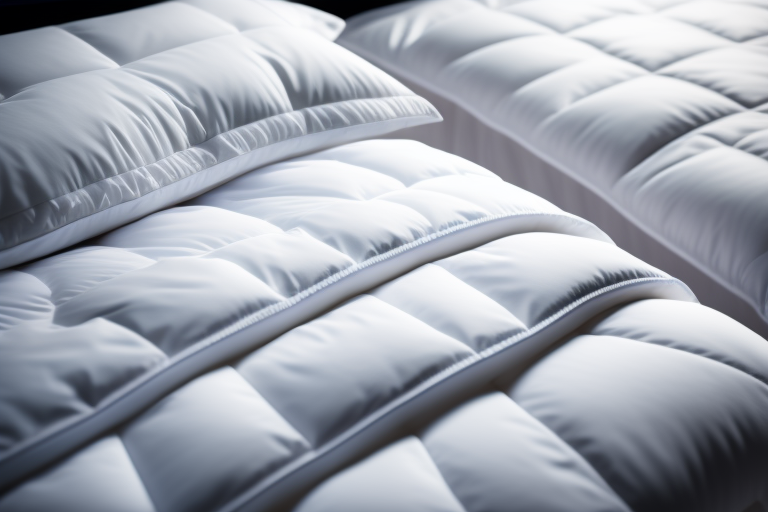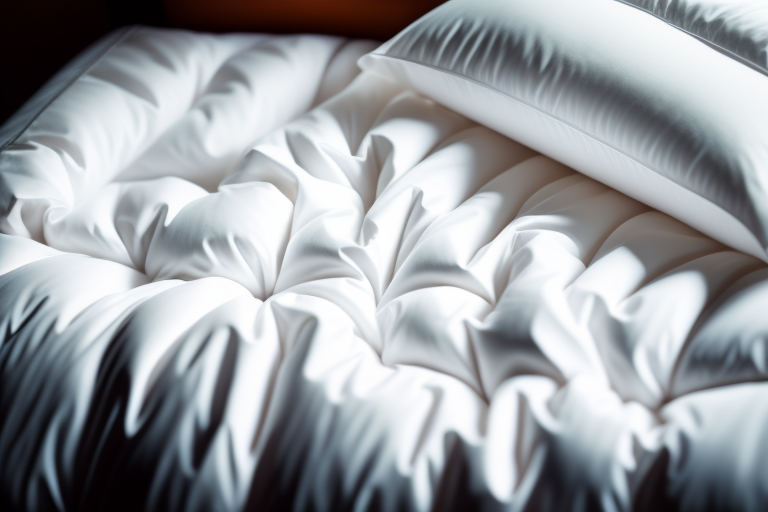Down comforters are one of the most luxurious and warm types of bedding you can own. That fluffy, lightweight feel comes from the unique properties of down filling. But how exactly are down comforters made? What materials and construction techniques give them that signature warmth and loft?
In this beginner’s guide, we’ll explore the ins and outs of down comforter manufacturing. We’ll look at the different components, construction methods, and design elements that go into a quality down comforter. You’ll learn how fill power, baffle boxes, and stitching all affect performance. We’ll also compare down to down alternative and talk about shopping considerations like size, cost, and care requirements.
Let’s get started! Here’s what we’ll cover:
How Are Down Comforters Constructed?
The first step in understanding how down comforters are made is looking at how they are put together. There are four main construction techniques used:
Baffle Box Construction
This is the highest quality technique and involves sewing fabric baffles or compartments to hold the down in place. The baffles prevent the filling from shifting around inside the comforter.
Sewn-Through Box Construction
With this simpler method, stitching goes through both the top and bottom layers of fabric to create down compartments. It’s less effective at preventing shifts but cheaper to produce.
Ring-Stitched Construction
Here, ring-shaped stitches attach the top and bottom layers of fabric together. The filling is divided into looped sections that help hold it in place.
Channel-Stitched Construction
This involves stitches going vertically down the comforter to create channels for the down to fill. It offers less stability than box stitches.
| Construction Type | Quality | Price |
|---|---|---|
| Baffle Box | Highest | Expensive |
| Sewn-Through Box | Medium | Low |
| Ring-Stitched | Medium | Medium |
| Channel-Stitched | Low | Cheap |
As you can see, baffle box is the highest quality while channel stitching is the most basic. Higher quality stitching keeps insulation stable and prevents cold spots.
Down Comforter Materials Explained
From the fluffy filling to the cozy outer cover, the materials used impact the comfort and quality of the down comforter.
Outer Shell Fabrics
The outer shell encases the down fill to make the comforter. Common materials include:
- Cotton: Breathable and soft but prone to shrinking
- Polyester: Durable and wrinkle-resistant but not breathable
- Sateen cotton: Soft like cotton but less shrinking
- Silk: Very soft and durable but expensive
- Rayon: Silky softness from an artificial fabric
High-end down comforters often use sateen cotton for its strength and soft feel. Some cheaper brands may use polyester for cost savings.
Fill Materials: Down vs. Down Alternative
Here’s a quick comparison of natural down versus synthetic down alternatives as comforter fills:
Down
- Made from duck or goose plumage
- Provides excellent insulation
- Super lightweight and fluffy
- More expensive than down alternative
- Allergies a concern for some
Down Alternative
- Made from polyester fibers
- Provides decent warmth for the weight
- Not as fluffy and light as down
- Cheaper than real down
- Hypoallergenic properties
The Responsible Down Standard (RDS)
With real down, ethical sourcing is a concern. RDS certification ensures humane practices for birds that supply down. Responsible brands like Snowe source RDS-approved down.
Understanding Fill Power
Fill power measures the loft or ability of down to expand and trap air. It’s key to warmth.
Higher fill powers (600-900+) mean:
- More insulation from loft
- Lighter and fluffier
- Higher quality down
Lower fill powers (under 600) mean:
- Less warm and cozy
- Heavier and more compressed down
- Lower cost and durability
That’s why comforters with 700-800+ fill power excel in warmth, while budget options often use fills around 500-600 power instead.

How Do Down and Down Alternative Comforters Compare?
Deciding between real goose down versus a down alternative polyester fill comes down to factors like:
Warmth and Weight
- Down provides the best warmth for the weight
- Down alternative is decently warm but heavier
Lifespan
- Down will last many years if cared for
- Down alternative loses loft faster over time
Cost
- Down alternative is the cheaper option
- Real goose down has a higher price tag
Allergies
- Down can trigger allergies in some
- Down alternative is hypoallergenic
Here is a comparison table summarizing the key differences:
| Feature | Down | Down Alternative |
|---|---|---|
| Warmth for Weight | Excellent | Decent |
| Longevity | Many years if cared for | Loses loft faster |
| Cost | Expensive | Budget-friendly |
| Allergies | Can trigger allergies | Hypoallergenic |
While down provides exceptional warmth and longevity, down alternative comforters are a quality budget option.
The Importance of Quality Materials
From baffle boxes to high fill power down, the materials and quality of construction have a big impact on performance and longevity.
Tightly Woven, Downproof Shells
The outer shell fabric must be tightly woven enough so feathers don’t poke through. Materials like sateen cotton or high-thread count cotton excel here.
Premium Down Fill
Splurge for 700-800+ fill power down certified to the Responsible Down Standard for ideal loft and warmth.
Durable Stitching
Attaching the shell layers together with sturdy baffle box stitching ensures fill stays evenly distributed.
With quality materials like these, your down comforter can last over a decade when properly cared for.
Down Comforter Shopping Guide
Ready to buy a down comforter? Keep these tips in mind while shopping:
Pick the Right Fill Power for Your Climate
600-650 fill power provides all-season warmth in most climates. For extra insulation, choose 700-900+ fill power.
Consider Budget
Down alternative and lower fill power down (under 600) are most budget-friendly. High fill power down costs more but delivers premium performance.
Choose the Right Size
Pick your regular bed size. Oversize comforters that drape over the sides are trendy but not necessary.
Feel the Fabric
Look for smooth, tightly woven shell fabrics labeled “downproof.” Avoid cheap polyester shells.
Check Construction Quality
Well-made baffle box or ring stitching prevents fill shifting. Avoid low-quality channel stitching.
Verify Responsible Sourcing
For down, ensure RDS certification for ethical harvesting practices.

Our Top 5 Down Comforter Picks
Based on quality construction and materials, here are my top recommendations:
| Brand | Name | Price | Key Features |
|---|---|---|---|
| Snowe | All Season Down Comforter | $249+700 fill RDS-certified down, cotton sateen shell | |
| Brooklinen | All-Season Down Comforter | $249 700 fill power, cotton sateen shell | |
| Buffy | The Cloud Comforter | $170-200Eco-friendly recycled materials, 650 fill | |
| Parachute | Down Duvet Insert | $349-399 750 fill power, double-gusset baffle boxes | |
| Cuddledown | 700 Fill Power Sateen Down Comforter | $259-939Baffle-box, satin-trim, 700+ fill power |
These quality down comforters provide exceptional warmth and durability to last years. The Brooklinen, Snowe, and Cuddledown options are great mid-range choices, while the Parachute down insert is a premium luxury pick.
Caring for Your Down Comforter
To extend the life of your down comforter:
- Dry clean every 2-3 years to sanitize and restore loft
- Air out the comforter several times per year
- Use a duvet cover to protect from stains
- Wash duvet cover regularly to avoid buildup of oils
- Fluff the comforter daily to maintain even fill distribution
- Store folded or on a hanger during summer
With proper care, a quality down comforter can last over a decade!
The Bottom Line
Hopefully this down comforter beginner’s guide gave you insight into how they’re constructed and what makes them so wonderfully warm. With responsibly sourced premium down, baffle box stitching, and a tight weave shell, these cozy blankets deliver comfort that lasts. Just be sure to select the right fill power, size, and shell fabric for your needs.
Frequently Asked Questions
What is the best fill power for a down comforter?
The ideal fill power for your down comforter depends on your climate and seasonal needs. 600-650 fill power works well for most people in an average climate. 700-900+ fill power provides extra insulation for cold regions or winter use.
How do I know if a down comforter will keep me warm enough?
Check the fill power rating – higher numbers around 700-900+ mean more warmth and insulation. Also consider your climate. Boost fill power if you live in colder regions.
What’s the benefit of baffle box construction?
Baffle boxes sewn into a down comforter keeps the down fill evenly distributed. This prevents cold spots and maintains insulation. Box baffles are the highest quality construction.
Is down or down alternative better for allergies?
Down alternative comforters with polyester fill are hypoallergenic so they’re better for allergy sufferers. Natural goose down can trigger reactions for some due to feathers and allergens.
How often should I clean my down comforter?
Every 2-3 years, have your down comforter professionally dry cleaned to restore fluffiness and sanitize. This preserves the insulation, loft and lifespan. Regularly wash the duvet cover to prevent buildup between cleanings.








